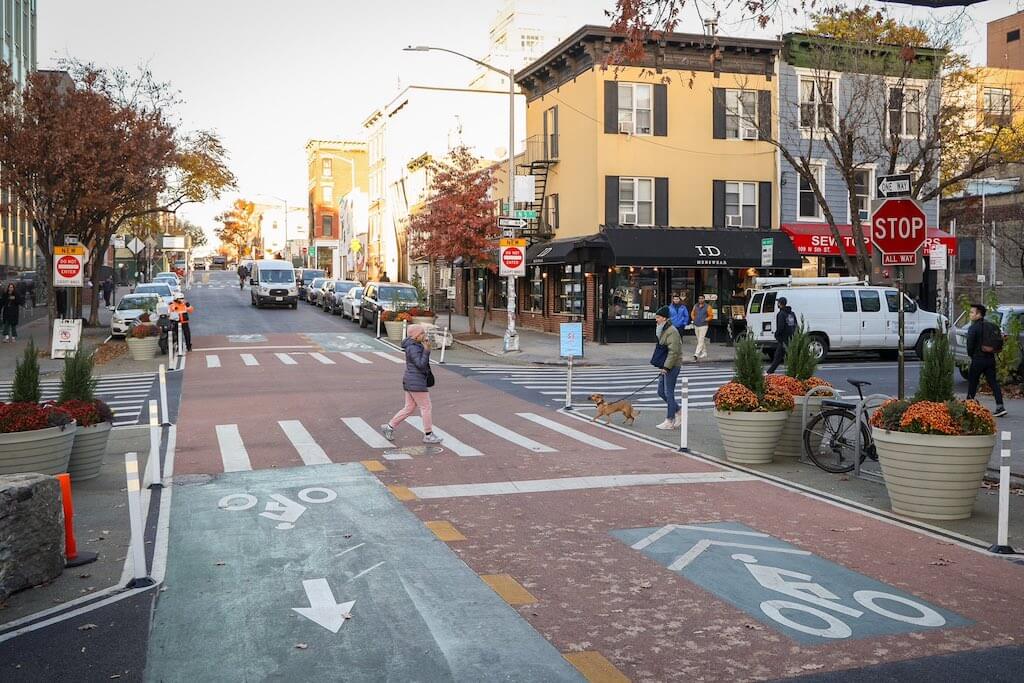Autumn Gear Guide
Find inspiration in our Gear Guide that will keep you out on your bike through wind or rain.
Download NowNew York City made an announcement that it was daylighting an additional 1,000 intersections per year. “Every year we’ve been doing close to 300 daylightings, but today … we are announcing that we’re going to be doing 1,000 daylighting intersection every year,” said New York City DOT Commissioner Ydanis Rodriguez, last fall. “And that’s added […]
New York City made an announcement that it was daylighting an additional 1,000 intersections per year.
“Every year we’ve been doing close to 300 daylightings, but today … we are announcing that we’re going to be doing 1,000 daylighting intersection every year,” said New York City DOT Commissioner Ydanis Rodriguez, last fall. “And that’s added to the other 1,000 redesigning danger intersections that we have already been doing. ”
LIVE NOW: @NYCMayor makes a street safety announcement at City Hall. https://t.co/QNrk1UgLdM
— NYC Mayor’s Office (@NYCMayorsOffice) November 30, 2023
Of course, New York City has more than 40,000 intersections, so it will take some time. But what is daylighting?
Simply put, it is clearing obstructions most importantly parked cars away from intersections where the vast majority of road violence occurs and thus increasing the visibility of cyclists, pedestrians and other vulnerable road users.
In New York City‘s case, the news comes just days after the utterly tragic news that a three-year-old was struck and killed by a driver in the borough of Queens.
According to advocacy group Transportation Alternatives, New York state law requires daylighting, but NYC has overridden it.
“By repurposing parking spaces to allow room for curb extensions, benches, Citi Bike docks, and bike parking, the City of New York can increase visibility and slow vehicle turning speeds,” read the Transalt.org website.
See the example below of how removing parking spaces too close to an intersection helped daylight it.
Explosion of rain gardens in Jaz Heights north of the Northern Blvd!
I thought perhaps they gave up on these as garbage collectors but perhaps in less dense areas w/ majority single family homes, fewer biz & less peds my assumption is that maybe they perform better. Good to see! pic.twitter.com/1J0p9D04bO
— Streetfilms (1,081+ videos!) (@Streetfilms) May 4, 2022
In the bustling landscape of urban environments, where traffic congestion is a daily challenge, promoting alternative modes of transportation, such as cycling and walking, has become a priority. One crucial aspect of creating a safer and more accommodating environment for cyclists is the concept of “daylighting” intersections.
In the context of urban cycling and commuting by bicycle, daylighting intersections offers a range of benefits that contribute to a more sustainable and cyclist-friendly cityscape.
One of the primary advantages of daylighting intersections is the enhanced visibility it provides for cyclists. By keeping the immediate vicinity of intersections clear from parked cars and other obstructions, cyclists become more visible to motorists. This increased visibility reduces the risk of collisions at intersections, a common hotspot for accidents involving cyclists. Improved sightlines also enable drivers to anticipate and respond to cyclists’ movements more effectively.

New York City daylighting (photo courtesy NYC DOT)
Daylighting intersections facilitates safer interactions between cyclists and motor vehicles. When the intersection area is free from obstructions, cyclists are less likely to be hidden from view, making it easier for drivers to spot them. This visibility is crucial for preventing right-hook collisions, where a turning vehicle crosses the path of an unseen cyclist. Clear sightlines empower both cyclists and drivers to navigate intersections with greater confidence and awareness.
While the focus is often on cyclist safety, daylighting intersections also benefit pedestrians. By maintaining clear zones around intersections, pedestrians are more visible to both cyclists and motorists. This promotes a safer environment for all road users, fostering a sense of shared responsibility and cooperation among different modes of transportation.
Daylighting intersections align with efforts to promote active transportation, such as cycling. Creating safer conditions for cyclists at intersections encourages more people to choose bicycles as a mode of commuting. This, in turn, contributes to reducing traffic congestion, lowering carbon emissions, and promoting healthier lifestyles. Cities that prioritize daylighting intersections send a clear message about their commitment to creating a cyclist-friendly urban landscape.
Incorporating daylighting strategies into urban planning reflects a commitment to sustainable and people-centric city design. By prioritizing the needs of cyclists and pedestrians, cities can create environments that are not only safer but also more enjoyable to navigate. This approach aligns with the broader goals of creating livable, sustainable urban spaces that prioritize the well-being of residents.
Daylighting intersections is a crucial component of creating safer and more cyclist-friendly urban environments. It’s a move that is happening across North America, and is a key component of Vision Zero programs in cities such as San Francisco.
The benefits extend beyond just improving visibility; they contribute to a broader shift towards sustainable and active transportation. As cities continue to grapple with the challenges of urbanization, prioritizing the safety and accessibility of cyclists through thoughtful urban planning, including the implementation of daylighting strategies, is a significant step towards creating more inclusive and livable communities.
Find inspiration in our Gear Guide that will keep you out on your bike through wind or rain.
Download Now
Leave a comment